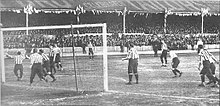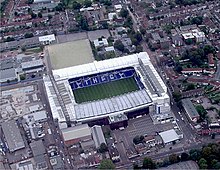Founded in 1882, Tottenham won the FA Cup for the first time in 1901, making it the only non-League club to do so since the formation of the Football League. Tottenham was the first club in the 20th century to achieve the League and FA Cup Double, winning both competitions in the 1960–61 season. After successfully defending the FA Cup in 1962, in 1963 it became the first British club to win a UEFA club competition – the European Cup Winners' Cup. In 1967 it won the FA Cup for a third time in the 1960s. In the 1970s Tottenham won the League Cup on two occasions and was the inaugural winner of the UEFA Cup in 1972, becoming the first British club to win two different major European trophies. In the 1980s Spurs won several trophies: the FA Cup twice, FA Community Shield and the UEFA Cup in 1984. In the 1990s the club won the FA Cup and the League Cup. When it won the League Cup once more in 2008, it meant that it had won a major trophy in each of the last six decades – an achievement only matched by Manchester United.
The club's Latin motto is Audere est Facere (lit: "To Dare Is to Do"), and its emblem is a cockerel standing upon a football. The club has a long-standing rivalry with near neighbours Arsenal, which is known as the North London derby.
History
Main article: History of Tottenham Hotspur F.C.

Sandy Brown (hidden) scoring the third goal for Tottenham Hotspur in the 1901 FA Cup Final replay against Sheffield United
Since then, Tottenham have won the FA Cup a further seven times, the Football League twice, the Football League Cup four times, the UEFA Cup twice and also the UEFA Cup Winners' Cup. The Cup Winners' Cup victory in 1963 made Tottenham the first English team to win a UEFA competition. In 1960–61 it became the first team to complete The Double in the 20th century.
Stadium
Tottenham Marshes
Tottenham played their first matches at Tottenham Marshes on the available public pitches and remained there for six years. It was at this ground that Spurs first played arch rivals Arsenal (then known as Royal Arsenal), leading 2–1 until the match got called off due to poor light after the away team arrived late.[5] There were occasions on which fights would break out on the marshes in dispute of the teams that were allowed to use the best pitches. Crowd sizes were regularly increasing and a new site was becoming needed to accommodate these supporters.Northumberland Park
In 1898 the club moved from the marshes to Northumberland Park and charged an admission fee of 3d £0.0125. They only remained at this ground for a year as in April 1899, 14,000 fans turned up to watch Spurs play Woolwich Arsenal. The ground was no longer able to cope with the larger crowds and the Spurs were forced to move to a new larger site 100 yards down the road, to the current ground.White Hart Lane
Main article: White Hart Lane

Aerial image of White Hart Lane
In 1905 Tottenham raised enough money to buy the freehold to the land and became permanent owners of the ground. As the club grew new stands were added. A new main stand was added in 1909, the East stand was also covered this year and extended further two years later. The profits from the 1921 FA Cup win were used to build a covered terrace at the Paxton Road end and the Park Lane end was built at a cost of over £3,000 some two years later. This increased the ground's capacity to around 58,000 with room for 40,000 under cover. The East Stand (Worcester Avenue) stand was finished in 1934 and this increased capacity to around 80,000 spectators but cost £60,000.
The pitch was thoroughly renovated in 1952. This uncovered a number of items from the old nursery on the site and one year later the first floodlights were introduced. The floodlights were upgraded in 1957 which required the cockerel to be moved from the West Stand to the East and then in 1961 floodlight pylons were installed.
The West Stand was replaced by an expensive (and way behind schedule) new structure. Various developments and upgrades were implemented over the years. In 1992, following the Taylor Report's recommendation that Premier League clubs eliminate standing areas, the lower terraces of the south and east stand were converted to seating, with the north stand becoming all-seater the following season. The south stand redevelopment was completed in March 1995 and included the first giant Sony Jumbotron TV screen for live game coverage and away match screenings. With this, the capacity of the stadium increased to just over 33,000. In 1997/98 season the Paxton Road stand had a new upper tier added which included the second Jumbotron screen and increased capacity to 36,240 and was funded by a rights issue in 1996.
Minor amendments to the seating configuration were made in 2006 bringing the current capacity of the stadium to 36,310.
Domestic
League- Football League Second Division:
- Winners (2): 1919–20, 1949–50
- Runners-up (2): 1908–09, 1932–33
- Southern League:
- Winners (1): 1899–1900
- Western League:
- Winners (1): 1903–04
European
- UEFA Cup Winners' Cup:
- Winners (1): 1963
- Anglo-Italian League Cup:
- Winners (1): 1971
Statistics and records
Main article: List of Tottenham Hotspur F.C. records and statistics
Steve Perryman
holds the appearance record for Spurs, having played 854 games for the
club between 1969 and 1986, of which 655 were league matches. Jimmy Greaves holds the club goalscoring record with 266 goals in 380 league, cup and European appearances.Tottenham's record league win is 9–0 against Bristol Rovers in the Second Division on 22 October 1977. The club's record cup victory came on 3 February 1960 with a 13–2 win over Crewe Alexandra in the FA Cup. Spurs' biggest top-flight victory came against Wigan Athletic on 22 November 2009, when they won 9–1 with Jermain Defoe scoring five goals. The club's record defeat is an 8–0 loss to 1. FC Köln in the Intertoto Cup on 22 July 1995.
The manager with the highest win percentage since 1899 is Andre Villas-Boas with 53.7%.
